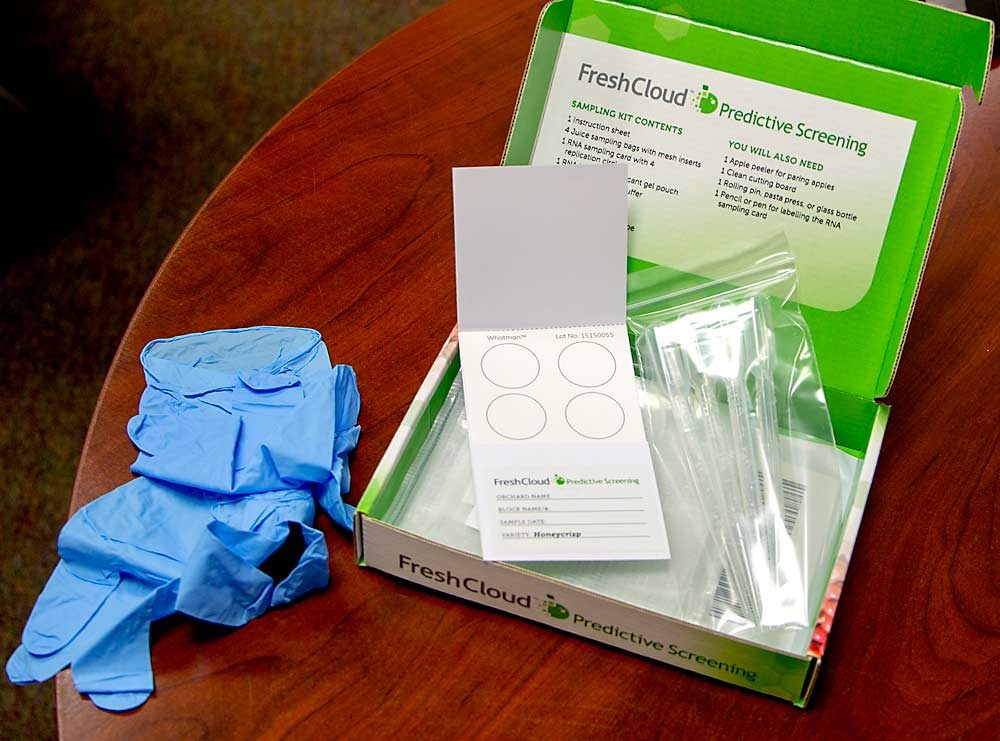
Most postharvest disorders don’t arise out of thin air.
It may seem that way, when good-looking fruit goes into storage but comes out months later showing bitter pit or scald, but the foundation for disorders was laid during the growing season. At-risk apples already show warning signs at harvest, or even before, if you know what to look for.
Making those invisible signs in the fruit’s physiology — known as biomarkers — visible creates a valuable tool for making better storage and marketing decisions.
That’s the goal of AgroFresh’s new predictive screening technology that allows growers to take small samples from Honeycrisp peels at harvest, mail those samples overnight to the company’s Yakima, Washington, labs, and within a few days get results estimating the risk of soft scald and bitter pit.

“How can growers use this information? We know that conditioning Honeycrisp reduces soft scald, but conditioning enhances bitter pit, so this information could help you decide how to strike that balance,” said lead genomics researcher Nigel Gapper, presenting the technology at the Washington State Tree Fruit Association’s annual meeting in December.
The insight doesn’t come cheap, at several hundred dollars per test kit, but if it can prevent losing a lot of Honeycrisp to a late-discovered disorder, it may be worth it.
“If you have the capacity to be able to ask questions about how the fruit are going to behave, you’re going to want to know,” said David Rudell, a physiologist for the U.S. Department of Agriculture in Wenatchee, Washington, who studies biomarkers for postharvest disorders.
The new commercial test is based on research he and others began a decade ago, looking at how apples differ in terms of gene expression and metabolites, eventually teasing out which differences were strong indicators for the development of disorders.
One of the first finds was a superficial scald biomarker, and Rudell developed a method warehouse managers could use to test organic Granny Smith. But the complexity of the required lab work likely made it out of reach for many. AgroFresh’s risk assessment test is the first commercial product to make the biomarker tests more accessible.
This season, the company plans to help introduce the technology to interested growers, sending trained staff to demonstrate how to use the sampling kits, Gapper said in a follow-up interview with Good Fruit Grower.
Peel samples from four different areas in a block are macerated, then juice is extracted and dripped onto paper cards that contain special compounds to stabilize the RNA so that it can be analyzed in the lab.
Gapper uses RNA biomarkers, which indicate what genes are being actively translated into proteins. “It’s the first gene expression change that’s measurable,” he said. “The metabolite is last.”
More than 60,000 RNA molecules have now been sequenced in apples.
Right now, the test is based on a “small suite of indicators,” Gapper said, but, eventually, he expects to scan samples for hundreds of molecules as they find more markers and improve accuracy.
For soft scald, the current test is 80 percent accurate, he said, with 16 percent false positives, which would lead to overly conservative decisions.
“We have around 4 percent false negatives, which is the problem for us, but we’re 96 percent confident that if we give you the prediction that you won’t see a problem, then you shouldn’t see that problem,” Gapper said.
Bitter pit accuracy is a bit better: 85 percent overall accuracy with 12 percent false positives and 3 percent false negatives.
Results are sent back through AgroFresh’s data management platform, FreshCloud, within a few days. He doesn’t give recommendations, just analysis to help inform decisions, Gapper said.
Future tests for soggy breakdown, Gala internal breakdown, lenticel breakdown in Fuji, and CO2 injury are in the works, Gapper said.
From a research perspective, they can find a biomarker for any disorder of interest, Rudell said. The question is which markers are valuable enough to make testing worthwhile, and that depends on what options warehouses have — or even growers, if the tests are done preharvest — once they have the information.
For superficial scald in Granny Smith, for example, packers might opt to treat organically grown fruit that shows susceptibility with conventional chemicals that minimize the disorder, Rudell said.
Or they may decide against conditioning Honeycrisp, to reduce the odds of developing bitter pit.
“It’s the beginning of asking the apple how it’s going to perform in the cold chain,” he said. “It’s not that different from a starch scale or mineral analysis. These are just more sophisticated tools.” •
—by Kate Prengaman
Related:






Leave A Comment